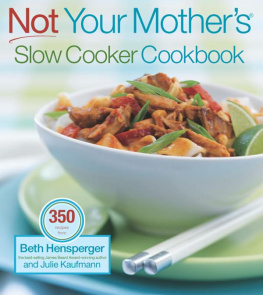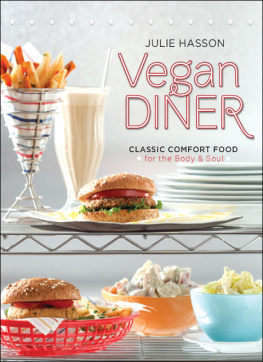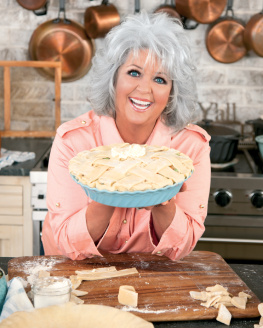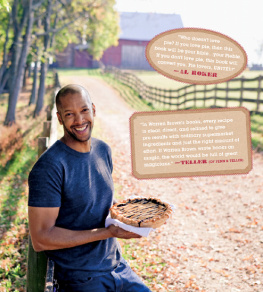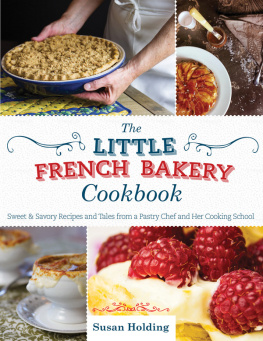This book is dedicated to the furry and the feathered, the scaly and the prickly. To the friends that share our home, and the friends we enjoy from afar. This book is for all the animals that give us joy and share our planet in peace.
Introduction
What Is a Vegan Diet?
If you are holding this book in your hands, you definitely have some interest in learning more about the vegan diet and lifestyle (or youre a vegan already!). Maybe you just want to reduce your meat consumption, or you find yourself considering making the switch to a completely animal-free lifestyle. In this introduction, we hope to answer many of the questions you may have.
Of course, you could also already know 99.99 percent of what there is to know about veganism and simply be on the lookout for new recipes to play with, in which case we hope a whopping five-hundred of them will be enough to keep you busy in the kitchenand well fedfor a long, long time.
Merriam-Websters Dictionary defines vegan as: A strict vegetarian who consumes no animal food or dairy products; also: one who abstains from using animal products (as leather).
Vegan not only describes the food someone eats, but often also refers to a lifestyle that vegans follow. Most vegans refrain not only from eating any animal products but also from using beauty products that contain animal derivatives; wearing animal products such as leather, wool, or fur; and generally using any type of animal product in their lives.
People who decide to follow a vegan diet do so for many reasons, some of which may include animal compassion, better health, environmental as well as economic issues, and religion. Maybe a friend or family member has decided to become a vegan, and you want to show support.
From the standpoint of those who decide to follow a vegan lifestyle for compassionate reasons, most feel that all living creatures have the same right to live a life without fear of being killed or tortured for a meal. Most vegans who follow the lifestyle for this reason are often also involved in animal rights groups and tend to volunteer at animal shelters.
A VEGAN DIET IS HEALTHY
FOR YOU
There is no doubt that leading a vegan lifestyle is better for your health. By its nature, the diet has zero cholesterol, very little saturated fat, and typically an astronomical amount of vitamins, nutrients, and minerals from a wide variety of plant-based sources. Those who choose to go vegan for better health need to understand that simply giving up meat and dairy in favor of french fries and pasta is not going to make them healthier. When making the decision to eliminate animal foods from your diet, it is imperative to understand how to successfully achieve optimum health through plant-based sources.
The question that is asked most often is how to get enough protein. There seems to be a lot of misinformation out there that claims the human body needs more protein than it actually does. There are many plant-based sources of protein that can easily provide the body with more than enough. Beans, nuts, lentils, soy products such as tempeh and tofu, and gluten-based foods such as seitan and grain meats are all excellent sources of heart-healthy proteins.
It is also important to ensure that vitamin and mineral needs are met through diet. Iron can be obtained through legumes, nuts, and seeds, as well as through enriched grains. Leafy greens such as kale and collards, broccoli, soymilk and other fortified nondairy milks, almonds, tofu, and figs can be excellent sources of calcium. Sea vegetables such as algae, kelp, and seaweed can be great sources of essential fatty acids and iodine.
Two of the most difficult vitamins to obtain through a vegan diet are vitamin D and vitamin B12. To increase the bodys absorption of vitamin D, make sure you get plenty of sun exposure during the warm months. Nutritional and dietary supplements such as nutritional yeast can easily be added to the diet to substantiate the vitamin B12 intake.
A VEGAN DIET IS HEALTHY FOR
THE ENVIRONMENT
From an environmental standpoint, the vegan diet is undoubtedly a sustainable way to eat. Each year the United States imports about 200 million pounds (90 million kg) of beef from Central America. Fuel costs and pollution aside, where does this beef come from? The grazing land needed to raise these cattle is often found by clear-cutting dense forests and rainforest land. Studies estimate that the necessity for more grazing land means that for every minute of every day, a land area equivalent to seven football fields is destroyed in the Amazon basin. For each hamburger that originated from animals raised on rainforest land, approximately 55 square feet (16.8 m) of forest have been destroyed. Its not just the rainforest. In the United States, more than 260 million acres of forest have been clear-cut for animal agriculture. With increased per capita meat consumption, and an ever-growing population, we can only expect to see more deforestation in the future.
In addition to needing land for raising meat, animal agriculture also requires water. In the United States, the amount of water needed for animal consumption is almost equivalent to all other uses of water combined. To grow 1 pound (0.45 kg) of beef requires about 2,500 gallons (9,463 L) of water. Compare that to 1 pound (0.45 kg) of soy, which only requires 250 gallons (946 L), or a pound (0.45 kg) of wheat, which requires only 25 gallons (94.6 L). In addition, it is an inefficient use of resources because it takes years to grow that single pound of beef. Think about it: the amount of water needed to produce just one hamburger is enough to take a nice long, hot shower every day for two and a half weeks. With numbers like these, eating vegan is surely the green way to go.
Beyond the waste is the pollution: agricultural pesticides and manure seep into the groundwater, eventually finding their way to the rivers and oceans. In addition to water pollution, the effect of animal agriculture on fossil fuels is tremendous. Each animal grown and slaughtered for food must be fed. The feed ranges from grain to soy products. The production of this feed requires energy to grow and transport. Imagine the amount of people that could be fed if we focused our agriculture on wheat and grain grown for human consumption rather than growing food for livestock.
A report in the New Scientist estimated that driving a hybrid car rather than an average vehicle would conserve a little over one ton of carbon dioxide per year. A vegan diet, however, consumes one and a half tons fewer than the average American diet. Adopting a vegan diet actually does more to reduce emissions than driving a hybrid car!
A VEGAN DIET IS HEALTHY FOR
YOUR POCKETBOOK
From an economic standpoint, it can be much cheaper to maintain a plant-based diet. Purchasing bulk pantry staples, such as dried beans, rice, and other grains, and supplementing them with fresh fruits and vegetables can save hundreds, possibly thousands, of dollars on your yearly grocery bill.
Many cultures and religions also have strict dietary guidelines. Following a plant-based diet can easily be adjusted to meet the guidelines of most cultures and religions.
Making the decision to eliminate animal-sourced ingredients, however, can be tricky, regardless of the reason. Ingredients youve probably never even heard of before will now become a part of your everyday language, and label reading will also become part of your shopping routine. In the beginning, this can add a little time to your trip to the market, but rest assured that in no time, it will become second nature.
There are countless websites and resources that have lists of ingredients that are animal-derived. Following is a concise list of the major offenders.


